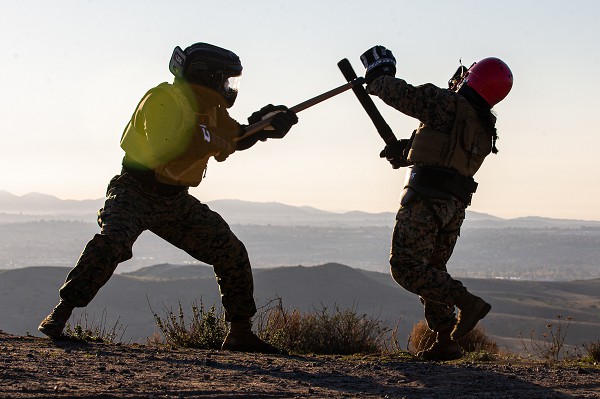
Marine Corps Base Pendleton, California. (December 8, 2022) In the above photo by Lance Corporal Gadiel Zaragoza, Sergeant Avery Luengo, left, a martial arts instructor with the 1st Battalion, 1st Marine Regiment, 1st Marine Division spars with Corporal Alexis Flippo, an imagery analysist specialist with 1st Intelligence Battalion, 1st Marine Expeditionary Force Information Group during a martial arts instructor course and physical training session. These courses certify Marines to instruct and monitor marital arts programs on hand-to-hand combat specifically designed for the Marine Corps mission.
Officially dubbed the Marine Corps Martial Arts Program, or MCMAP, the course teaches a unique fighting discipline developed specifically for the Marines that blends a variety of martial arts disciplines into close quarter battle techniques using a variety of weapons, including items one may find laying around a battlefield.
All Marines earn a Tan Belt before graduating recruit training (the equivalent of a white belt in most disciplines), and depending on your occupational specialty, you may be required to earn a grey or even green belt with further training.
The first Marine Corps martial artists trained to fight in cramped spaces aboard American warships in 1775 where proficiency in hand-to-hand combat with knives or bayonets was the hallmark of Marine Corps training. The course requires students to climb a ladder of Belts signifying their proficiency level in various martial arts forms. Widely adopted in 2002, the MCMAP borrows heavily from the martial arts disciplines of Israeli Crav Maga, Brazilian Jiu Jitsu, and traditional wrestling.
Besides teaching warriors how to fight, the MCMAP also emphasizes discipline, ethics, education, and a strong moral character. The MCMAP wasn’t meant to re-invent ancient martial arts disciplines, but rather to combine the best elements of hand-to-hand training from multiple arts to create the most capable war fighters possible.


